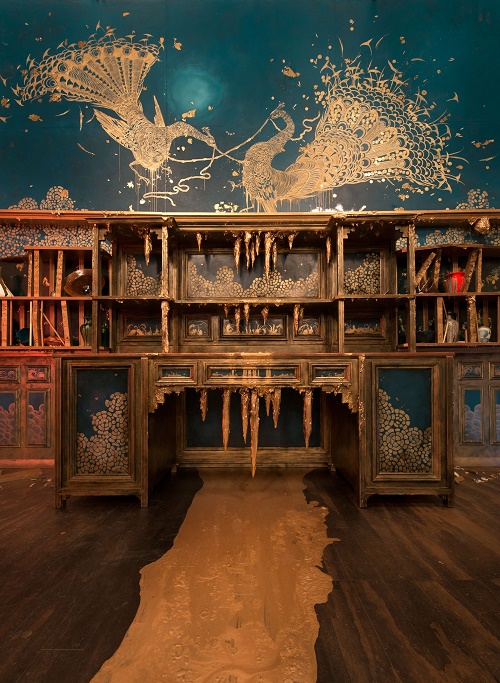Peacock Room REMIX: Darren Waterston’s “Filthy Lucre”

Peacock Room REMIX: Darren Waterston’s Filthy Lucre
Arthur M. Sackler Gallery, Washington, DC, through January 2017
The Peacock Room by James McNeil Whistler is composed of a full room of elaborately decorated panels that were designed for Frederick R. Leyland, a British businessman and an art collector, for his London dining room in 1876. This indoor mural reflects Whistler’s dedication to creative freedom and his strong desire to achieve aesthetic perfection. Later, Charles Lang Freer, an American collector, purchased Whistler’s Peacock Room and installed it in his own dining room in Detroit. After Freer’s death in 1919, the Peacock Room was moved to Washington D.C. where it is permanently on view at the Smithsonian’s Freer Gallery of Art.
The Peacock Room serves as the inspiration for Darren Waterston’s Filthy Lucre, a parody of the famous nineteenth century interior and the centerpiece of the exhibition “Peacock Room REMIX.” In this immersive installation, Waterston envisions the Peacock Room as a dystopian parallel universe of chaos and destruction. Filthy Lucre also alludes to Whistler; it is a play on the title of Whistler’s painting The Gold Scab: Eruption in Filthy Lucre (1879)—an artwork that criticizes his patron’s obsession with money and wealth. Despite these numerous ties to Whistler and his Peacock Room, the exhibition enables visitors to appreciate Waterston’s Filthy Lucre as an independent artwork.
“Peacock Room REMIX” consists of three different sections: an overview of the history of the Peacock Room, selected preparatory studies of Filthy Lucre, and Filthy Lucre itself. The visitor first confronts a large video documentary, which narrates the history of Whistler’s Peacock Room and the drama that arose between Whistler and Leyland over money.
The adjoining space displays a series of Waterston’s preparatory works for Filthy Lucre. These mesmerizing, minuscule, abstract watercolors and sketches are studies for the decorative designs of the 250 distorted, broken, cracked, and neglected ceramic works in Filthy Lucre. The exhibition draws additional attention to the artistic process with the display of Waterston’s interpretive sketches based on Whistler’s The Princess from the Land of Porcelain. Through these preparatory works, the visitor gains access to Waterston’s methodology and creative practice, underscoring Filthy Lucre’s value as an autonomous contemporary installation.
Finally, the visitor is transported into an atmosphere of decadent disorder and chaos upon entering Filthy Lucre. There, the viewer is overwhelmed by the visual and chromatic intensity of the enclosed space. A background soundscape composed by the New York-based band BETTY amplifies this sensorial overload. Although the room is slightly smaller than the original Peacock Room, this difference in size is not easily discernable. Besides the damaged yet attractive ceramics and heavily embellished wooden frames, the visitor is also confronted with the disfigured face of the female figure in Waterston’s parody of The Princess from the Land of Porcelain and a violent painting of fighting peacocks who are picking, pulling, and twisting each other’s guts.
This exhibition is timely as the Freer Gallery temporarily closed in January 2016 for renovation. When it first opened in May 2015, “Peacock Room REMIX” provided an opportunity to compare and contrast Whistler’s nineteenth century total work of art with Waterston’s contemporary interpretation. Now with the Freer Gallery’s temporary closure, “Peacock Room REMIX” serves as a substitute platform through which visitors may vicariously experience the real Peacock Room. Moreover, with the absence of the original, the exhibition’s inclusion of its history serves to highlight the tensions between Whistler and Leyland, thus opening up new avenues of discussion on the artist, his work, and his patrons.